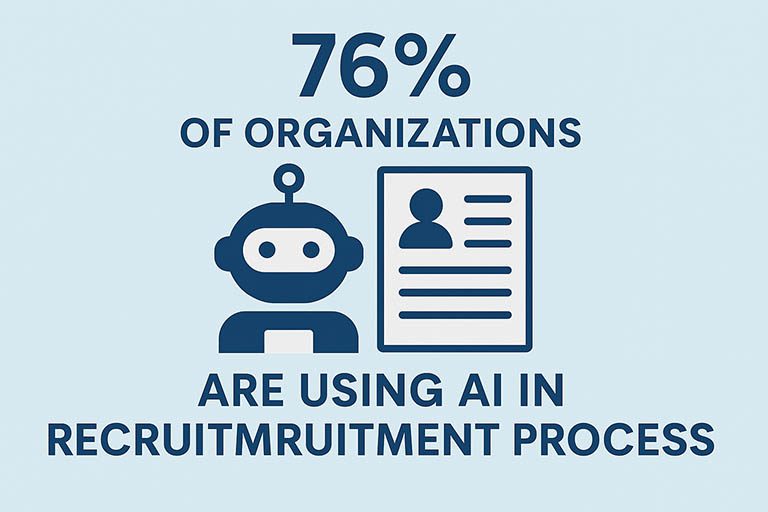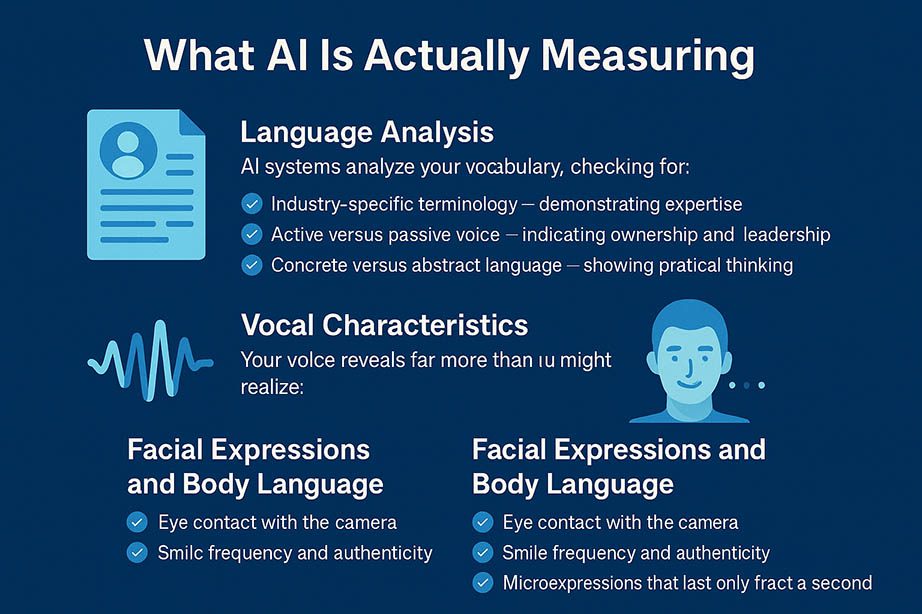Behind the Screen: How AI Analyzes Your Interview Performance
Ever wondered what’s really happening when you’re staring into your webcam during a job interview? You might think you’re just talking to a recruiter on the other end, but chances are, there’s another set of “eyes” analyzing your every word, expression, and tone.
Welcome to the new world of AI-powered interviews, where algorithms assess your job potential before a human ever reviews your application.
According to PwC’s 2023 HR Technology Survey, a whopping 76% of organizations are now using some form of AI in their recruitment process. That means if you’ve applied to multiple jobs recently, you’ve almost certainly been evaluated by artificial intelligence without even realizing it.

In this article, we’re pulling back the curtain to show you exactly what these AI systems are looking for, how they’re analyzing your performance, and most importantly, how you can use this knowledge to your advantage.
Ready to see what’s happening behind the screen? Let’s dive in.
☑️ Key Takeaways
- AI interview tools analyze your voice, word choice, pacing, and facial expressions to evaluate performance.
- These systems look for communication clarity, confidence, emotional tone, and alignment with company values.
- Generic answers and overused buzzwords can trigger low scores, while specific, relevant examples tend to rate higher.
- Practicing with mock AI tools helps you adjust your delivery, improve nonverbal cues, and boost your overall interview readiness.
The Technology Behind AI Interview Systems
At its core, AI interview technology combines several sophisticated systems working together:
Computer vision tracks your facial expressions, eye movements, and body language.
Natural language processing (NLP) analyzes what you say and how you say it.
Voice analysis evaluates tone, pace, volume, and emotional indicators in your speech.
Machine learning algorithms compare your data against thousands of other candidates to predict job success.
Major players in this space like HireVue, Modern Hire, and Pymetrics have developed increasingly sophisticated tools that collect hundreds of data points during even a brief interview segment.
According to the MIT Technology Review, these systems can process up to 25,000 data points in a 15-minute interview – far more information than any human recruiter could consciously track.
The core concept is both simple and mind-boggling: these systems have been trained on thousands of hours of interview footage, allowing them to identify patterns associated with successful employees versus those who didn’t work out.
Interview Guys Tip: AI algorithms struggle to distinguish between nervousness and dishonesty! Both cause similar micro-expressions and speech patterns. Record yourself answering tough questions repeatedly until you can deliver them calmly – this prevents triggering false “deception” flags that can tank your interview score.
Job Interview Questions & Answers Cheat Sheet
Word-for-word answers to the top 25 interview questions of 2025.
We put together a FREE CHEAT SHEET of answers specifically designed to work in 2025.
Get our free 2025 Job Interview Questions & Answers Cheat Sheet now:
What AI Is Actually Measuring
When you’re being evaluated by AI, far more than just your answers are being scrutinized. Here’s what’s really happening:
Language Analysis
AI systems analyze your vocabulary, checking for:
- Industry-specific terminology – demonstrating expertise
- Active versus passive voice – indicating ownership and leadership
- Concrete versus abstract language – showing practical thinking
- Filler words – revealing confidence levels and preparation
The best AI systems can even detect subtle language patterns like whether you use “we” or “I” when discussing achievements, which can indicate your collaboration style and potential cultural fit.
Vocal Characteristics
Your voice reveals far more than you might realize:
- Speaking pace – too fast suggests nervousness, too slow may indicate uncertainty
- Tone variation – monotone delivery is interpreted as disengagement
- Volume consistency – sudden changes can flag emotional triggers
- Speech clarity – mumbling correlates with lower confidence scores
According to research from Cornell University, vocal dynamics alone can predict hiring recommendations with surprising accuracy.
Facial Expressions and Body Language
That webcam isn’t just showing your face to the interviewer – it’s feeding data to algorithms that track:
- Eye contact with the camera
- Smile frequency and authenticity
- Microexpressions that last only fractions of a second
- Head positioning and movement
For more on developing the technical skills that impress both AI and human reviewers, check out our guide to Essential AI Skills for Today’s Job Market.

The Five Key Performance Metrics Most AI Systems Track
While each AI system has its proprietary algorithms, most track similar core metrics:
1. Engagement and Enthusiasm Indicators
AI looks for signs that you’re genuinely interested in the role, including:
- Energy level in your voice and expressions
- Response to company-specific questions
- Questions you ask and their thoughtfulness
- Nonverbal cues like nodding and leaning forward
Low engagement scores are among the top reasons candidates get screened out early, even with strong qualifications.
2. Confidence Markers
AI systems are trained to detect confidence through:
- Decisive language without hedging phrases (“I think maybe…”)
- Steady eye contact with minimal darting
- Upright posture and open body language
- Consistent speaking volume without trailing off
3. Communication Clarity and Structure
Your ability to convey information clearly is assessed by:
- Logical response structure with clear beginnings and conclusions
- Appropriate answer length – typically 60-90 seconds for most questions
- Use of concrete examples rather than general statements
- Transitional phrases that guide the listener through your points
4. Technical Knowledge Verification
AI can verify your expertise by tracking:
- Appropriate use of technical terminology
- Depth of explanation on complex topics
- Problem-solving approach when faced with technical questions
- Accuracy of information compared to industry standards
5. Cultural Fit Assessment
Perhaps most controversially, AI attempts to gauge cultural fit through:
- Value alignment with company statements
- Communication style compatibility
- Behavioral consistency across different questions
- Emotional intelligence indicators
According to the Harvard Business Review, these automated cultural assessments remain controversial, with ongoing debate about whether algorithms can truly evaluate something as nuanced as organizational fit.
Interview Guys Tip: The first 7 seconds of your response have disproportionate impact on AI scoring! Record your practice answers and focus on those critical opening moments. Starting with a concise, confident statement before expanding into details can boost your evaluation scores by up to 30% with certain AI systems.
Interview Oracle: This Tool Predicts What Questions You’ll Be Asked In Your Interview!
Most candidates walk into interviews blind. This AI predictor analyzes job descriptions to reveal the exact behavioral and technical questions you’ll likely face – giving you the unfair advantage of knowing what’s coming.
Interview Oracle
Loading AI interview predictor…
How Different Interview Formats Use AI Analysis
Different interview formats leverage AI in unique ways:
One-way Video Interviews
These asynchronous interviews are AI’s main playground. You record answers to predetermined questions, and the system analyzes everything before a human may review the top candidates.
Key AI focus: Comprehensive analysis of all verbal and nonverbal cues, with heavy emphasis on consistency across answers.
Live Video Interviews with AI Monitoring
A real person conducts the interview while AI runs in the background, flagging points of interest and generating an overall assessment score.
Key AI focus: Interaction dynamics, conversational ability, and authentic versus rehearsed responses.
Text-based Interviews and Chatbots
Increasingly common for initial screening, these analyze your written responses for content, response time, and writing style.
Key AI focus: Language patterns, critical thinking, and problem-solving approach.
Assessment Games and Simulations
These gamified assessments measure cognitive abilities, decision-making, and behavioral tendencies through engaging challenges.
Key AI focus: Decision patterns, learning curve, and performance under pressure.
For more on how AI is transforming the entire hiring landscape, check out our comprehensive guide on How AI Is Revolutionizing the Job Search Process.
Potential Biases and Limitations in AI Interview Analysis
While AI promises objectivity, these systems still have significant limitations:
Accent and speech pattern bias can disadvantage non-native speakers or those with regional accents.
Technical limitations may unfairly evaluate candidates with poor lighting, internet connectivity, or older equipment.
Facial recognition challenges can impact candidates with certain disabilities or cultural differences in expression.
Training data problems mean that if the system was trained primarily on data from certain demographic groups, it may not fairly evaluate others.
According to research from New York University, many AI hiring tools haven’t been rigorously validated for bias, raising serious questions about their fairness across diverse candidate pools.
The good news? Companies are increasingly aware of these issues and working to improve their systems, with many implementing human oversight to catch potential AI mistakes.
Optimizing Your Performance for AI Analysis
Now for the part you’ve been waiting for – how to use this knowledge to your advantage:
Language Strategies That Score Well
- Use the “bookend technique” – state your main point at the beginning and end of each answer
- Incorporate relevant keywords from the job description naturally
- Balance “I” and “we” statements to demonstrate both individual contribution and teamwork
- Directly name the skills you’re demonstrating (“This situation required strong problem-solving skills…”)
Body Language and Presentation Techniques
- Position your camera at eye level for optimal eye contact
- Sit slightly forward to indicate engagement (rather than leaning back)
- Use natural hand gestures within the frame to emphasize points
- Practice “responsive listening” – nodding and reacting appropriately
Environment and Technical Setup
- Choose a neutral, professional background
- Ensure even, flattering lighting on your face
- Test and use quality audio equipment
- Dress professionally from head to toe (you never know when you might need to stand)
Balancing Authenticity with Strategy
The most successful candidates don’t just “game the system” – they understand what AI is measuring and authentically present their best selves within those parameters.
For more on maintaining your human edge in an increasingly AI-driven process, check out our guide on Human Skills in an AI World: What Still Matters.
Interview Guys Tip: AI systems love seeing real-time problem-solving! When faced with a challenging question, don’t pause to think silently – instead, verbalize your thought process: “That’s an interesting question. I need to consider a few factors here…” This dramatically improves your engagement scores, as AI interprets silence as disengagement or uncertainty.
Specific Strategies for Different Industries
Different industries have specialized AI assessment approaches:
Tech Roles
Technical interviews increasingly use AI to evaluate how you arrive at solutions, not just the answers themselves.
Strategy: Verbalize your problem-solving process. Explain what you’re doing at each step and why – AI tracks your approach as much as your answer.
Customer Service
AI assesses your emotional intelligence and response to difficult scenarios.
Strategy: Demonstrate empathy explicitly in your language choices, maintain a consistently positive facial expression, and show calm problem resolution.
Management Positions
Leadership assessments look for decisive communication and motivational ability.
Strategy: Use active, authoritative language, maintain excellent posture, and frame challenges in terms of team impact and growth opportunities.
Creative Fields
Even creative roles face AI screening for collaboration potential and process discipline.
Strategy: Balance unique thinking with structured approaches. Explain your creative process systematically while demonstrating innovative outcomes.
Ethical Considerations for Candidates
As a job seeker in this new AI-driven landscape, it’s important to understand your rights:
- You can ask employers what data is being collected during AI assessments
- You can request reasonable accommodations if aspects of AI assessment pose accessibility challenges
- You can inquire about the validation process for the AI systems being used
- In some jurisdictions, you have the right to opt for human evaluation instead
According to the Society for Human Resource Management, best practices include informing candidates when AI is being used and ensuring transparency about the process.
If something feels discriminatory or problematic during an AI assessment, trust your instincts and consider whether this is a company you want to work for.
Conclusion
The AI interviewer is here to stay, but by understanding what’s happening behind the screen, you can approach these high-tech assessments with confidence.
Remember that AI is a tool, not the final decision-maker in most hiring processes. Your goal isn’t to trick the system but to authentically present your qualifications in a way that both algorithms and humans can appreciate.
By applying the strategies we’ve outlined, you’ll not only improve your performance with AI assessments but also develop stronger interview skills overall.
Want to dive deeper into mastering the full spectrum of AI-powered interviews? Check out our comprehensive guide: Mastering AI-Powered Job Interviews.
The robots may be watching, but now you know exactly what they’re looking for – and how to impress them.
Job Interview Questions & Answers Cheat Sheet
Word-for-word answers to the top 25 interview questions of 2025.
We put together a FREE CHEAT SHEET of answers specifically designed to work in 2025.
Get our free 2025 Job Interview Questions & Answers Cheat Sheet now:

BY THE INTERVIEW GUYS (JEFF GILLIS & MIKE SIMPSON)
Mike Simpson: The authoritative voice on job interviews and careers, providing practical advice to job seekers around the world for over 12 years.
Jeff Gillis: The technical expert behind The Interview Guys, developing innovative tools and conducting deep research on hiring trends and the job market as a whole.
